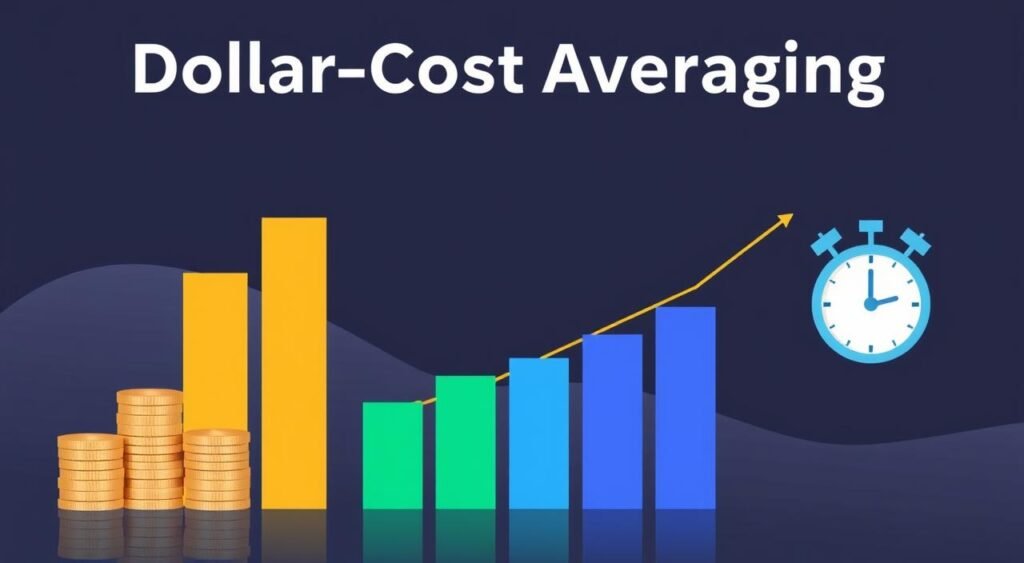Do you remember the first time you held a $100 bill? It felt like anything was possible. Now, imagine that feeling but with the chance to grow your money. Investing with $100 is a smart move that can change your financial future.
Investing isn’t just for the wealthy anymore. Anyone can start growing their money with just a few dollars and some smart strategies. The world of investing has opened up, offering budget-friendly options for beginners.
There are many ways to turn your $100 into more money. Options like fractional shares and micro-investing apps make it easy. It’s not about how much you start with. It’s about starting smart and sticking with it.
Let’s look at how you can make your first $100 work for you. This guide is for anyone wanting to manage their money better and secure a brighter financial future. It’s perfect for college students, young professionals, or anyone wanting to make their money grow.
Key Takeaways
- Investing can start with as little as $100
- Fractional shares allow access to high-value stocks
- Micro-investing apps make regular investing easy
- Diversification is possible through ETFs and index funds
- Consistent investing beats timing the market
- Robo-advisors offer low-cost portfolio management
- Early start in investing can lead to significant long-term growth
Understanding the Power of Small Investments

Small investments can lead to big returns over time. The key is to start early and stay consistent. Many people think they need large sums to invest, but this isn’t true. Low-cost investments can grow significantly through compounding returns.
The Importance of Starting Early
Time is your greatest ally when investing. Starting early allows your money to grow exponentially. For example, a $5,000 investment earning 8% annually can grow to over $50,000 in 30 years without additional contributions. This showcases the power of compound returns.
How Small Investments Grow Over Time
Consistent small investments can yield impressive results. Investing just $100 monthly in an IRA for 30 years, based on historical S&P 500 performance, could result in almost $180,000. This growth is due to compounding returns and market performance over time.
Affordable Investment Options
There are many affordable investment options available today. Stock index funds offer instant diversification by owning a piece of all companies in that index. Fractional shares allow you to buy portions of high-priced stocks with smaller amounts. Robo-advisors can create personalized portfolios based on your financial situation and goals.
“The best time to plant a tree was 20 years ago. The second best time is now.” – Chinese Proverb
Remember, it’s not about how much you start with, but how consistently you invest and how long you stay invested. Low-cost investments, when combined with time and compounding returns, can help you build substantial wealth.
Building a Strong Financial Foundation

Smart money management begins with a solid financial base. It’s key for those new to investing who want to use their money wisely. Let’s look at the main parts of building a strong financial foundation.
Creating an Emergency Fund
An emergency fund is your financial safety net. Begin by saving $1,000 for small emergencies. Try to increase this to cover three months of expenses. Use automatic payroll deductions to help you save faster. Think of your emergency savings as “debt free insurance” to avoid using it for other things.
Paying off High-Interest Debt
High-interest debt can slow down your financial growth. Credit card debts have interest rates of 13-20%, much higher than the 6-10% return on investments. Pay off these debts before investing. Use tools like the DebtBlaster Calculator to make a good debt payoff plan.
Setting Clear Financial Goals
Set your financial goals to guide your investment choices. Think about how much risk you can take and when you want to invest. Use websites like Mint.com to make a realistic spending plan. Remember, planning your finances is ongoing. Check your spending regularly, especially after big life changes like a new job or marriage.
- Save for emergencies
- Pay off high-interest debt
- Set clear financial goals
- Review and adjust your plan regularly
By focusing on these key areas of smart money management, you’ll be ready to look into high-yield investments. This will help you start your investing journey well-informed.
Exploring Low-Cost Investment Options

Now, starting to invest with a budget is easier than before. You can begin with just $100 and grow your financial future. Affordable investment options let beginners step into finance without spending a lot.
Index funds and ETFs are great for those looking for low-cost investments. They give you a mix of different sectors, following the market’s performance. Plus, many brokers offer free trades, making it simpler to start investing with a small amount.
Fractional shares have changed the game for budget investing. You can buy a part of high-priced stocks like Amazon or Google without spending a lot. It’s perfect for beginners wanting to get into top stocks without needing a lot of money.
- Index funds: Low-cost, diversified investment
- ETFs: Traded like stocks, offer broad market exposure
- Fractional shares: Own partial shares of expensive stocks
Success in investing comes from being consistent and patient. By adding to your investments regularly, you can see the power of growth over time. Begin with a small amount, stay dedicated, and watch your investments increase.
Investing with $100: Practical Approaches

Starting your investment journey doesn’t need a big sum of money. With just $100, you can try different ways to grow your wealth. Let’s look at some easy options for beginners.
Micro-investing Apps and Platforms
Micro-investing has changed how people save and invest. Apps like Acorns have a Lite version starting at $1 a month, great for those with $100 or less. These apps let you invest spare change from daily buys, making saving easy.
Fractional Shares: Accessing High-Priced Stocks
Fractional share investing lets you own parts of expensive stocks. Platforms like Webull let you start with as little as $5, without extra fees. This way, you can diversify your portfolio with a small budget.
Index Funds and ETFs for Instant Diversification
For quick diversification, think about index funds and ETFs. Funds like the Fidelity Zero Large Cap Index and Schwab S&P 500 Index Fund can be bought for less than $100 with no minimum. These options give you exposure to many sectors, spreading your risk.
Remember, being consistent is crucial when investing with small amounts. Investing $100 a month, with a 9.2% return rate, could grow to $19,972 in ten years. Start small, stay consistent, and see your investments grow over time.
Leveraging Robo-Advisors for Beginners

Robo-advisors have changed the game for new investors, letting you start with just $100. These platforms use smart algorithms to create and manage your portfolio. They match your financial goals and how much risk you can handle.
For those new to investing, robo-advisors are a great choice. They pick your investments and balance your portfolio for you. This is ideal for those who prefer not to get too involved in their investments.
Many top robo-advisors have low or no minimums, making them easy for beginners to use. For instance, Betterment, a well-known robo-advisor, doesn’t require a minimum investment. Their basic plan costs just 0.25% each year, which is quite competitive.
Here are some key benefits of robo-advisors for beginners:
- Low fees compared to traditional financial advisors
- Automatic portfolio rebalancing
- Tax-loss harvesting to optimize returns
- Easy-to-use mobile apps for on-the-go investing
Even small investments can grow a lot over time with robo-advisors. By putting in $100 each month, you can build a big portfolio. This is thanks to compound interest and dollar-cost averaging.
It’s important to research and compare different robo-advisors to find the right one for you. Some top choices include Wealthfront, SoFi Automated Investing, and Acorns. Each has its own features and fees.
Maximizing Employer-Sponsored Retirement Plans

Employer-sponsored plans are a great way to start saving for retirement. These plans, like 401(k)s, come with special benefits that can really help your savings grow.
Taking Advantage of 401(k) Matching
Many employers add money to 401(k) plans. This is like getting free money for your retirement. For instance, an employer might add 100% of what you put in up to 3% of your salary, and 50% on the next 2%. So, if you put in 5%, your total savings would be 9% with the employer’s help.
Understanding Pre-tax Contributions
401(k) plans let you make contributions before taxes. This lowers your taxable income now. In 2024, you can put up to $23,000 into your 401(k). If you’re 50 or older, you can add another $7,500. These savings grow without taxes until you take them out in retirement.
The Power of Compound Growth
Employer-sponsored plans use the power of compound growth. Your money, plus any employer match, can grow a lot over time. Starting early and saving regularly is key to building a big retirement fund.
- Set up automatic contributions to make saving a priority
- Think about using automatic escalation to increase your savings rate over time
- Spread your investments out to manage risks
Remember, employer plans are just part of your retirement plan. Adding Individual Retirement Accounts (IRAs) can make your retirement strategy even stronger.
Exploring Individual Retirement Accounts (IRAs)

IRAs are a great way to improve your retirement savings. They come in two types: traditional and Roth. Each has its own benefits for your future.
Traditional IRAs let you deduct your contributions and grow your money without taxes until you take it out. Roth IRAs, on the other hand, let you take your money out tax-free in retirement. This is great if you think you’ll be in a higher tax bracket later on.
For 2024, you can put up to $7,000 into an IRA, or $8,000 if you’re 50 or older. This extra room lets you save more for your future.
“IRAs are an excellent option for those who have maxed out their employer-sponsored plans or want additional retirement savings vehicles.”
When picking an IRA provider, look at their fees and what investments they offer. Reddit users often recommend Fidelity, Vanguard, and Schwab. Fidelity is the top choice with over 36% of the vote, followed by Vanguard at 30%, and Schwab at 28.5%.
- Vanguard offers low-cost options with an average expense ratio of 0.08%
- Betterment charges 0.25% annually for portfolio management
- SoFi provides fee-free IRA management
Withdrawing money from IRAs too early can cost you. For Roth IRAs, you can take money out tax-free after 59½ if you’ve had the account for at least 5 years. Knowing these rules helps you use your IRA well and plan for a good retirement.
The Benefits of Dollar-Cost Averaging

Dollar-cost averaging is a smart way to invest and grow your money over time. It means putting the same amount of money into the market at regular times, no matter the market’s state.
How It Works and Why It’s Effective
This strategy helps you buy more shares when prices are low and fewer when they’re high. This can make your average cost per share go down. For instance, investing $100 a month in a stock means you buy 50 shares at $2 each and 20 shares at $5 each.
Implementing a Consistent Investment Strategy
To use dollar-cost averaging, set up automatic investments at set times. This could be every week, month, or quarter, based on your finances. Dollar-cost averaging helps you invest regularly, which is key for growing your wealth over time.
Reducing the Impact of Market Volatility
Dollar-cost averaging helps you handle market ups and downs better. By investing regularly, you don’t try to guess the best time to invest. This is especially good for new investors who are still learning about the market.
- Lowers investment costs over time
- Boosts returns in the long run
- Removes emotional decision-making
- Provides a disciplined approach to investing
Dollar-cost averaging might not always beat investing a lump sum, but it’s a steady way to grow your portfolio. It’s great for starting with smaller amounts or for those who want a steady investment plan.
Harnessing the Power of Dividend Investing

Dividend investing is a way to earn passive income and grow your wealth over time. It means buying stocks that pay out dividends regularly. This gives you steady cash and the chance for your investment to grow.
Dividend investing greatly affects your investment returns. Look at these surprising facts:
- Dividend payments made up over 30% of total equity market returns in Canada from 1986 to 2013.
- Reinvesting dividends nearly doubled market price returns during the same period.
- Dividend-paying stocks have historically outperformed market indices with lower volatility.
Starting with $100, dividend investing can be a wise choice for the long run. By reinvesting dividends, you can speed up your wealth growth. This makes your money work harder for you.
“Dividend investing is not just about current income. It’s about building a growing stream of passive income that can support your financial goals for years to come.”
Strategies focused on dividends have shown great success: – Dividend growers achieved 11.7% compound annual total returns. – Even dividend cutters saw 5.9% returns. – Non-dividend payers trailed with -0.5% returns.
For beginners, starting small with dividend investing can lead to big long-term gains. It’s a solid way to build wealth and earn passive income. This makes it a great choice for those wanting to make their $100 investment count.
Avoiding Common Pitfalls for New Investors
New investors face many challenges when they start in finance. It’s key to understand investment risks and build diverse portfolios for long-term success. Let’s look at common mistakes and how to dodge them.
Steering Clear of Get-Rich-Quick Schemes
Fast money can be tempting but often leads to trouble. Research shows most investment gains come from smart planning, not quick trades. Aim for steady growth and keep “fun money” investments to 5% of your portfolio.
The Dangers of Penny Stocks
Penny stocks may seem cheap but are risky. They often have low liquidity and can be manipulated. It’s best to skip stocks under $5 to $10 with no dividends. Beginners should start with no-load mutual funds or low-cost ETFs instead.
Importance of Diversification and Patience
Diversifying your portfolio helps manage risks. Don’t put more than 5% to 10% in one investment. Mix assets like index funds, Treasury bonds, and dividend stocks. Warren Buffett’s long-term investment in Coca-Cola shows the power of patience in investing. Remember, avoiding common investment mistakes is key for long-term success.
“The stock market is a device for transferring money from the impatient to the patient.” – Warren Buffett
By avoiding these pitfalls and focusing on diverse portfolios and long-term strategies, new investors can lay a strong foundation for financial growth.
Conclusion
Starting with $100 can help beginners build wealth over time. By investing a little each month, you can use the power of compound growth. For example, the S&P 500 stock index has made about 13.88% each year for the last ten years. This turned $10,000 into $36,683.82.
For beginners, it’s smart to choose low-cost options like index funds and ETFs. These choices give you a mix of investments right away. Using retirement plans and IRAs from your job can also help grow your wealth. Dollar-cost averaging is great for reducing the effects of market ups and downs, especially when you’re starting small.
High returns from investing with borrowed money might seem appealing, but it comes with big risks. A 15% drop in value on a $1600 investment could lead to losing 330% of your initial $100. For building wealth over the long term, being consistent and patient is essential. By focusing on steady growth and reinvesting earnings, your $100 monthly investment could grow a lot, beating inflation and securing your financial future.
FAQ
How can I start investing with just $100?
Now, you can start investing with $100 thanks to fractional shares and micro-investing apps. These options let you get into the stock market with a small amount. You can start building wealth right away.
Why is it important to start investing early, even with a small amount?
Starting early with small amounts lets you use compound growth to your advantage. The longer your money grows, the bigger the returns can be. This is because your investments grow on top of each other over time.
How can I overcome the misconception that I need a large sum of money to start investing?
You don’t need a lot of money to start investing. Thanks to low-cost options and micro-investing apps, you can start with as little as $100. This makes it easier to begin building wealth.
What are some low-cost investment options for beginners with limited funds?
Beginners can try index funds, ETFs, fractional shares, and micro-investing apps. These options are affordable and let you get into the stock market with a small investment.
How can micro-investing apps and fractional shares help me invest with a small amount?
Micro-investing apps let you invest small amounts regularly, like rounding up your purchases. Fractional shares let you buy parts of expensive stocks. This makes it easier to diversify your portfolio with a small budget.
What are the benefits of using robo-advisors as a beginner investor?
Robo-advisors offer automated investment advice tailored to your goals and risk level. They’re great for beginners because they manage your portfolio and have low fees and account minimums.
How can I maximize my employer-sponsored retirement plan for long-term growth?
Use any employer matching in your 401(k) plan, as it’s free money. Also, contribute as much as you can afford. These plans grow your money with tax benefits and compound over time.
What are the benefits of investing in an Individual Retirement Account (IRA)?
IRAs, like traditional and Roth IRAs, offer tax benefits for retirement savings. Traditional IRAs let you deduct contributions and grow your money tax-deferred. Roth IRAs offer tax-free withdrawals in retirement, making them great for long-term growth.
How can dollar-cost averaging help me as a beginner investor?
Dollar-cost averaging means investing the same amount regularly, no matter the market. This strategy can reduce the effect of market ups and downs. It can also lower your average cost per share over time, making it a good long-term strategy.
What are the advantages of dividend investing?
Dividend investing means buying stocks or funds that pay dividends regularly. You can reinvest these dividends to buy more shares. This can lead to compound growth and a steady income stream, along with potential long-term growth.
What are some common pitfalls for new investors to avoid?
Avoid quick-rich schemes, high-risk investments, and following hot tips. It’s important to diversify, keep a long-term view, and not take too much risk. This is especially true when you’re starting with a small investment.







